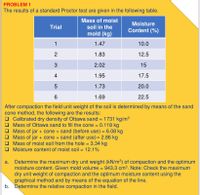
Structural Analysis
6th Edition
ISBN: 9781337630931
Author: KASSIMALI, Aslam.
Publisher: Cengage,
expand_more
expand_more
format_list_bulleted
Concept explainers
Question

Transcribed Image Text:PROBLEM 1
The results of a standard Proctor test are given in the following table.
Mass of moist
Moisture
soil in the
mold (kg)
Trial
Content (%)
1
1.47
10.0
2
1.83
12.5
3
2.02
15
1.95
17.5
5
1.73
20.0
1.69
22.5
After compaction the field unit weight of the soil is determined by means of the sand
cone method, the following are the results:
O Calibrated dry density of Ottawa sand = 1731 kg/m3
O Mass of Ottawa sand to fill the cone = 0.118 kg
O Mass of jar + cone + sand (before use) = 6.08 kg
O Mass of jar + cone + sand (after use)= 2.86 kg
O Mass of moist soil from the hole = 3.34 kg
O Moisture content of moist soil = 12.1%
%3D
Determine the maximum dry unit weight (kN/m3) of compaction and the optimum
moisture content. Given mold volume
943.3 cm3. Note: Check the maximum
dry unit weight of compaction and the optimum moisture content using the
graphical method and by means of the equation of the line.
b.
Determine the relative compaction in the field.
a.
Expert Solution
This question has been solved!
Explore an expertly crafted, step-by-step solution for a thorough understanding of key concepts.
This is a popular solution
Trending nowThis is a popular solution!
Step by stepSolved in 3 steps with 3 images

Knowledge Booster
Learn more about
Need a deep-dive on the concept behind this application? Look no further. Learn more about this topic, civil-engineering and related others by exploring similar questions and additional content below.Similar questions
- Consider that a 58.7 gram sample of dry soil is used in making a mechanical analysis by using the hydrometer method. The laboratory was held at a constant temperature of 20 C (68 F). The 40 s hydrometer reading was found to be 32.5 and the 8 hr hydrometer reading was 15.5. The percentage of sand in this soil sample is (note, a 58.7 gram sample is used here): Your Answer: Answer unitsarrow_forward2. A sample of dry coarse - grained material of mass 500 g was shaken through a nest of sieves and the following results were obtained. a) Plot the particle size distribution curve. b) Determine the effective size, the average particle size, the uniformity coefficient and the coefficient of curvature. c) Determine the textural composition of the soil. Sieve No. Opening (mm) Mass retained (g) 4 10 20 40 100 200 Pan 4.75 2.00 0.85 0.425 0.15 0.075 0 14.8 98 90.1 181.9 108.8 6.1arrow_forwardSG is 2.66 and temperature is 18 degrees celciusarrow_forward
- The results of a standard Proctor test are given in the following table. Determine the maximum dry density (kg/m3) of compaction and the optimum moisture content. Volume of Proctor mold (cm3) Mass of wet soil in the mold (kg) Moisture content (%) 943.3 943.3 943.3 943.3 943.3 943.3 943.3 943.3 1.6 1.71 1.77 1.83 1.86 1.88 1.87 1.85 9.9 10.6 12.1 13.8 15.1 17.4 19.4 21.2arrow_forwardA liquid limit test on a clay was performed with the following results. The natural water content of the clay is 38% and plastic limit is 21%. Number of Blows 6 12 20 28 32 Water content (%) 52.5 47.1 42.3 38.6 37.5 What is the plasticity index of this clay? (Use Interpolation) Group of answer choices 15.74% 18.99% 18.85% 17.63% Please answer this asap for upvote. thanksarrow_forward
arrow_back_ios
arrow_forward_ios
Recommended textbooks for you

 Structural Analysis (10th Edition)Civil EngineeringISBN:9780134610672Author:Russell C. HibbelerPublisher:PEARSON
Structural Analysis (10th Edition)Civil EngineeringISBN:9780134610672Author:Russell C. HibbelerPublisher:PEARSON Principles of Foundation Engineering (MindTap Cou...Civil EngineeringISBN:9781337705028Author:Braja M. Das, Nagaratnam SivakuganPublisher:Cengage Learning
Principles of Foundation Engineering (MindTap Cou...Civil EngineeringISBN:9781337705028Author:Braja M. Das, Nagaratnam SivakuganPublisher:Cengage Learning Fundamentals of Structural AnalysisCivil EngineeringISBN:9780073398006Author:Kenneth M. Leet Emeritus, Chia-Ming Uang, Joel LanningPublisher:McGraw-Hill Education
Fundamentals of Structural AnalysisCivil EngineeringISBN:9780073398006Author:Kenneth M. Leet Emeritus, Chia-Ming Uang, Joel LanningPublisher:McGraw-Hill Education
 Traffic and Highway EngineeringCivil EngineeringISBN:9781305156241Author:Garber, Nicholas J.Publisher:Cengage Learning
Traffic and Highway EngineeringCivil EngineeringISBN:9781305156241Author:Garber, Nicholas J.Publisher:Cengage Learning


Structural Analysis (10th Edition)
Civil Engineering
ISBN:9780134610672
Author:Russell C. Hibbeler
Publisher:PEARSON

Principles of Foundation Engineering (MindTap Cou...
Civil Engineering
ISBN:9781337705028
Author:Braja M. Das, Nagaratnam Sivakugan
Publisher:Cengage Learning

Fundamentals of Structural Analysis
Civil Engineering
ISBN:9780073398006
Author:Kenneth M. Leet Emeritus, Chia-Ming Uang, Joel Lanning
Publisher:McGraw-Hill Education


Traffic and Highway Engineering
Civil Engineering
ISBN:9781305156241
Author:Garber, Nicholas J.
Publisher:Cengage Learning